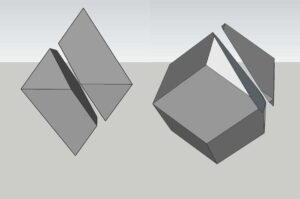Definition
The ability of a material to split along a certain plane or planes with weak atomic bonding.

A crystal structure is built up out of bonded atoms. These atoms lie in a regular repeating three-dimensional array. Although regular, the bonds and positions of atoms often look different in various directions. Some planes have a large number of atomic bonds and are very strong but some weaker planes occur in directions where there are fewer atomic bonds. It is along these planes that splitting may occur. Cleavage only occurs in crystalline substances.
Consequences
Cleavage is of great interest to the lapidary. It allows the cutter to shape a rough crystal into desired dimensions while retaining the cut-off piece(s) for later use. In diamond cutting, this technique is used extensively. Whenever possible a diamond cutter will use cleaving over a saw because it’s faster and cleaner. In addition to this, a cutter should always be making sure that none of the facets he will cut lie parallel to a cleavage plane; the facet will not take a good polish when this happens.
A goldsmith should be aware of a stone’s cleavage directions when setting it. Too much pressure or a knock in the wrong direction could cause the stone to split.
To the gemologist cleavage planes or half-developed cleavage planes (incipient cleavage) can be of help when identifying a stone. A cleavage plane can be visible as a colorful area due to interference. By knowing which material cleaves in what way the gemologist can be brought closer to a conclusion when identifying a gemstone.